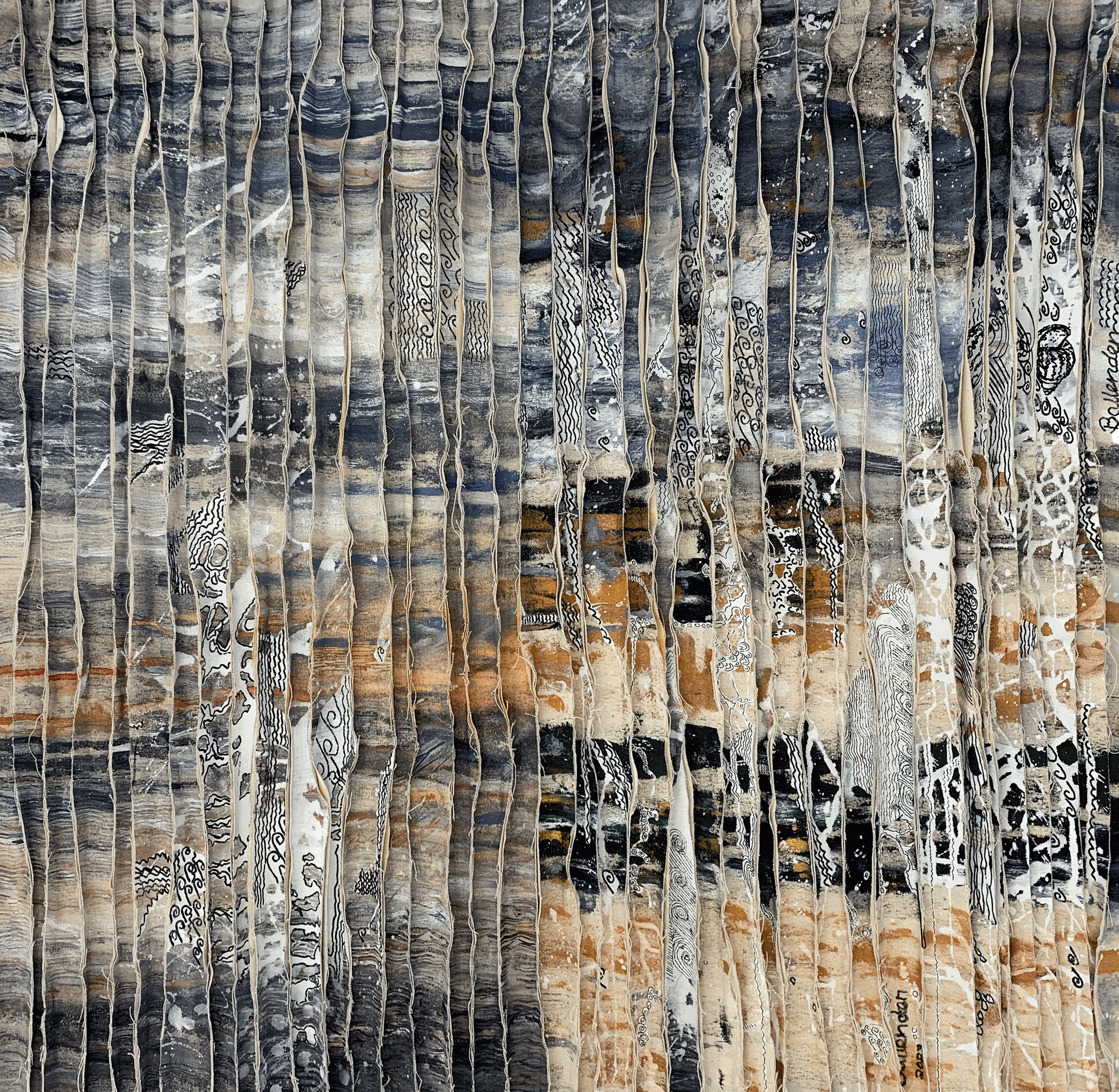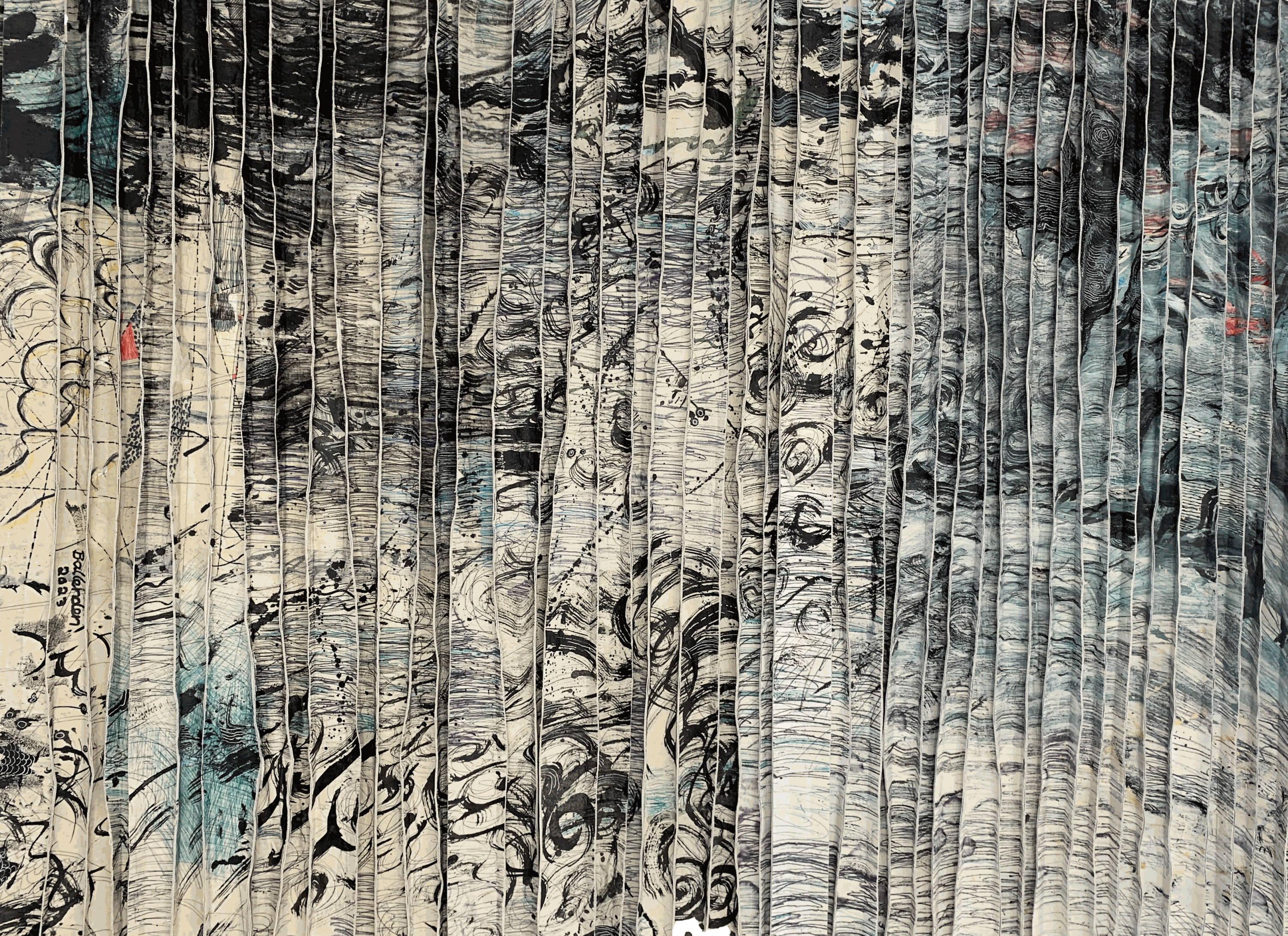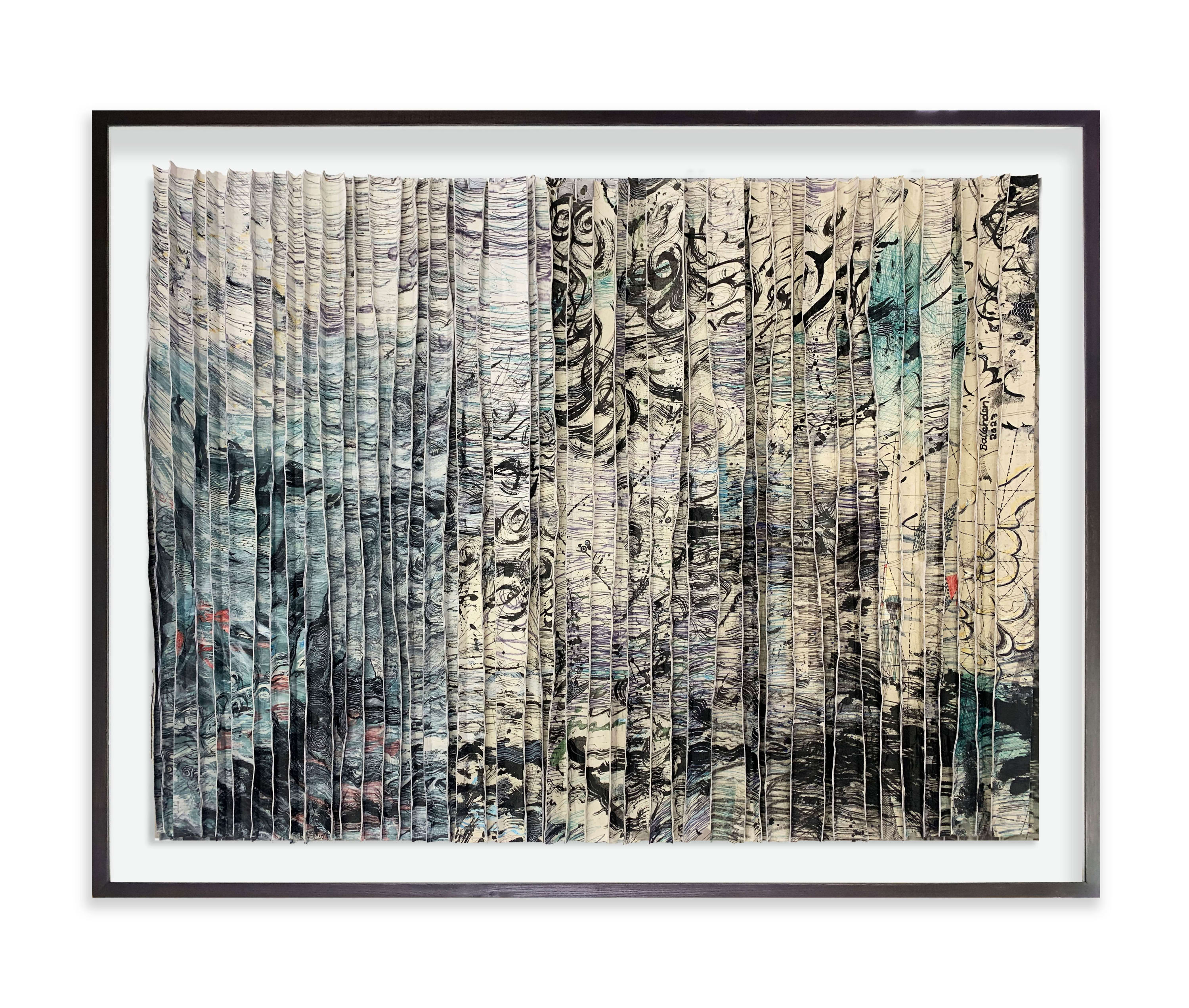-
A key process in the creation of your work is that of reconstruction and deconstruction. I have two questions in relation to this.
- Q: Why do you consciously incorporate destruction (such as burning and cutting) into your work?
A: It was not a process that began consciously, rather it emerged when I was a young artist having no confidence and I would produce work feeling that nothing was ever good enough. So often I would get angry and disillusioned and then destroy the work I created. I would literally throw the work away in ashes or I would cut it up with a knife.I used to shred my work and it was only in 2015 when I got a residency at the Bag Factory that my work changed. Given that it was a residency and I was in a public place, I could no longer throw a tantrum and cut up my work, so I began to speak to myself and question what I would now be able to do if I hated my work. Thereafter I began to give myself permission to cut the work up carefully with love and I made the decision to stop being destructive towards myself and my work. This then became a conscious process of controlled cutting and assembling, which created the abstract work I do today.-
Q: Why reconstruct new abstract work from that which has been destroyed?
A: Yes, reconstruction is the new positive way. It is a very powerful process that I see myself using, as it really has meaning and history, so the use of this process is not for aesthetic reasons. I am fascinated and grateful that a very destructive way of working grew into a very constructive way of working. It is so unique to me, the way I am working. However, it is not totally unique because there are many artists that deliberately cut up their work and then find ways to use those pieces, whereas mine comes from a history of a fundamental lack in confidence and the need for complete deconstruction.There is an art therapy word called ‘sublimation’ and it means to destroy and then find a way of healing and piecing together. My first experience of consciously understanding what I was doing and how I was working was when I did a course in art therapy. We were actually asked to produce an artwork because everyone in the class were artists. We worked on the artworks for approximately 3 hours and then the woman who was running the course told us to destroy our works in any form of our choosing. That was what we did then and it was so interesting because the process was very much about our own personal therapy. What we did not expect was to be told to take the pieces of the artworks we had just destroyed and lovingly reassemble them and put them together. I did that course after my mother passed away many years ago and when I went to the residency at the Bag Factory, this experience came back to me and I realised the power in taking anger and choosing to be constructive rather than destructive.Only 7 years ago, my work changed from figurative painting into abstract work. Before those 7 years, I would be very destructive to my work, except when I really loved what I had done. I will say that a significant part of my creativity was destroyed. However, I took photographs of my work in the process of making it - I have actually always been very good at documenting my work, simply out of interest for the creative process. What is very interesting is looking back at the work I destroyed and feeling a sense of disbelief.Now I would say that my work has evolved into a combination of catharsis and sublimation, of deconstruction and reconstruction, because as a young artist I did not necessarily intellectualise creative mediums, but as an older and more established artist, I grew to understand myself and know my process. Other artists find the understanding of their process when they are much younger, so I would say I am sort of a late developer in that regard but I am ultimately very happy with the work that I am producing. -
You used to photograph the busyness of the city, the poor, and this tends to form a starting point for your work. I have two questions in relation to this.
-
Q: Would you not say that there is an aspect of voyeurism in photographing the poor?
A: No, it is recognition of myself. My work is a diary of my life, so any situation happening in my life at a present moment will inspire and influence my work. The time I was at August House, there were moments where I would look out of my studio window down onto the street, onto the poverty there and I would reinterpret the poverty I saw. What I saw was that there were people who would collect rubbish and they would use it. They were people that were so poor that they would dig around in the rubbish and reconstruct it for whatever their needs were. So I related to what was being done and I thought how incredible it was in relation to my process where I rubbish my work, but the only difference is that I do it consciously.The works I created that were inspired by this observation were exhibited at Gallery 2 in an exhibition called “City of Gold - Cash for Scrap”, so you can see the ambiguity of what I was working with. So it was not voyeurism, it was a body of work created from the notion that “one man’s rubbish is another man’s treasure” and it came to me rather accidently, because that was my environment at the time. It was recognition, as I saw beauty in the rubbish even though people do not often see that.I am currently living in the Eastern Cape and I am right next to the sea and so my new body of work is entirely inspired by living near the sea. These works are very peaceful and gentle. See my artworks have changed again, yet the process remains the same - I am still deconstructing and reconstructing, because I have realised this to be a beautiful process to work with. Now I work from a place of intellectually understanding my process that evolves through time.-
Q: Why draw inspiration from your surroundings such as a city of poverty and not something more internal, more personal?
A: My own life experience pushes me to create, so I am completely inspired by my environment, but my environment is chosen through personal circumstances. These environments are not accidental and my art is very emotionally-based. So the new work that I am currently producing is about living in the environment of the sea, the sand, nature - it is about healing, finding a way to get through grief. -
-
-
Q: Before your work became abstract, it was figurative, such as your 1995 series which is rather dark and hints at internal struggle. Can you please elaborate on that.A: I had a difficult childhood and my mother subjected me to a particular traumatic event that I have carried with me throughout my life. I assign no blame though. So those dark figures continued until I shifted to abstract art. What is very interesting is that the other reason that I consciously moved away from figurative art is that everytime I draw figures, the story of my difficult childhood seeps into the work. When I draw figures, I never show the face of the figure, because I have carried so much shame in my life that I could never draw the face of the figures, they were always covered by hands. It is a known fact in psychology that when you cut yourself or you suffer from a mental illness, it helps you to feel a sense of control over your emotions. So that sense and process of cutting in my abstract art is a very cathartic experience for me.
-
Q: What artists (either located locally or abroad) are a source of inspiration for your work?A: The French artist Louise Bourgeois, the American artist called Mark Bradford who lives in L.A and I would say he has been the biggest inspiration for me. Then there is El Anatsui. What has happened is that I have had many favourite artists throughout my life. When I look back, my favourite artists have always been abstract - even Louise Bourgeois is abstract, the way she works is not reality and I am very drawn to abstract work.Once you draw and paint well, which was my situation, I got bored. Part of the reason so many artists move toward abstract art is because they see the world as shape and form and you do not see the figure anymore, the figure dissolves and it becomes interesting to work with. To have balance and get something to work compositionally is much more challenging. You have no reference to work with, it comes from within rather than seeing the world. But it is the process of being figurative, one does not just become abstract. So abstract art is the natural evolution for most artists. There is a perception that abstract art is escapism, this moving away from reality but for me, the word ‘escape’ is maybe too emotional. It is more experience as an artist but I can say that my emotional experience led me to be an abstract artist. However you jump in and out of consciousness about what you do - so the source is accidental but the process has become conscious.







